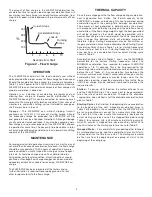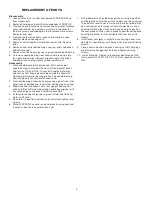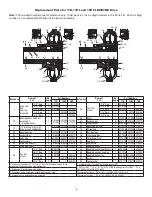
2
The amount of flow charge in the FLEXIDYNE determines the
acceleration time for a given load. Longer acceleration times will
occur when less flow charge is used and faster acceleration, from
stop to full speed, will be observed with greater amounts of flow
charge.
Seconds from Start
Acceleration Amps
Lock-In
400
300
200
100
10
8
6
4
2
In-rush Amps
Running
Amps
%
Figure 2 - Flow Charge
OPERATION
The FLEXIDYNE should start the load smoothly and without
delay provided the proper amount of flow charge has been used.
Should the acceleration time exceed the maximum allowable in
Table 1, shut off power to the FLEXIDYNE immediately. Allow the
FLEXIDYNE to cool, then add small amounts of flow charge until
proper acceleration is observed.
Vibration is an indication of accelerating too rapidly and not
allowing flow charge to become evenly distributed in the
FLEXIDYNE housing. This can be corrected by removing small
amounts of flow charge until vibration subsides. Other causes of
vibration are, undersize shafting, unit not installed far enough on
shaft or worn bore in the unit.
Slippage – The FLEXIDYNE can, without slipping, transmit
overloads up to 130% of its present starting torque. Should
this breakaway torque be exceeded the FLEXIDYNE will slip
and generate heat (see Overload Protection). Although slippage
usually indicates increased loads, it can also be caused by worn
flow charge or a worn rotor especially if the FLEXIDYNE has been
in operation for some time. The necessity to replace either a rotor
or flow charge will be made evident by a loss in power transmitting
capacity of the FLEXIDYNE.
MAINTENANCE
For average industrial applications involving 3 or 4 starts a day of
not mere than 6 seconds acceleration time each, the flow charge
should be changed every 10,000 hours of operation. For more
severe conditions, visually inspect flow charge at more frequent
intervals; it should be changed when it has deteriorated to a
half powder, half granular condition. Visual inspections should
continue until enough flow charge changes have been made to
adequately establish a schedule for renewing FLEXIDYNE flow
charge.
The FLEXIDYNE has been lubricated at the factory and no
further lubrication is required. Never apply grease, oil or any
other foreign material to the flow charge.
THERMAL CAPACITY
Since there is slippage within the flow charge during acceleration,
heat is generated from friction. The thermal capacity of the
FLEXIDYNE is based on balancing this heat generated during
acceleration against the cooling time between accelerations.
The amount of heat generated is determined by the amount
of horsepower dissipated by slipping and the duration of each
acceleration. If the flow charge weight is light, the heat generated
will not be as great as that which would be generated with a
heavier flow charge, when compared at the same acceleration
time. A longer time between starts will dissipate more heat;
therefore, higher starting horsepowers may be transmitted, or
longer acceleration times may be allowable. (See Starting Cycle)
Acceleration times shown in Table 1 are for starting frequencies
of one start per hour or less. If starting frequency is more than
once per hour, use acceleration time for actual starting cycle
shown in Table 2.
Acceleration times listed in Tables 1 and 2 are the MAXIMUM
permissible for the various starting frequencies listed. The
MINIMUM acceleration time required for proper FLEXIDYNE
operation is 1 to 1½ seconds. This is the time required for the
flow charge to be uniformly distributed around the housing cavity
before the unit “locks in”. Any acceleration time between the
minimum and maximum listed is acceptable, although a shorter
acceleration time will generally provide longer wear life. For
applications requiring a specific acceleration time (within these
limits) flow charge may be added or removed to produce the
required results.
Stalled
– If a jam-up stalls the drive, the motor continues to run
and the FLEXIDYNE slips. This causes heat to be generated at
twice the rate of normal acceleration. Therefore, the allowable
slipping time, when stalled, is half the allowable acceleration time
given in Table 1.
Starting Cycle
is the time from the beginning of one acceleration
to the beginning of the next. Allowable acceleration times in
Table 2 are based on the assumption that the FLEXIDYNE will
be running continuously except for a momentary stop before
the next start. If the stop is more than momentary, decrease the
actual starting cycle by one-half the stopped time before using
Table 2; for example, with a 50 minute actual starting cycle of
which 20 minutes is stopped time, decrease 50 by half of 20 to
give 40 minutes as the starting cycle time to use for Table 2.
Grouped Starts
– For several starts grouped together followed
by uninterrupted running, add the acceleration times of all starts
and consider it as the time for one start. The starting cycle would
be the time from the beginning of one group of starts to the
beginning of the next group.


























